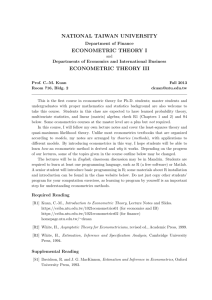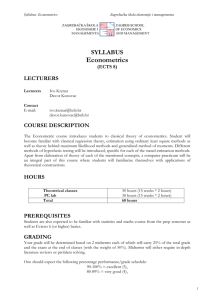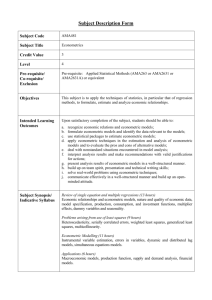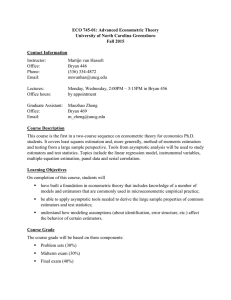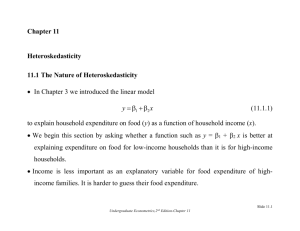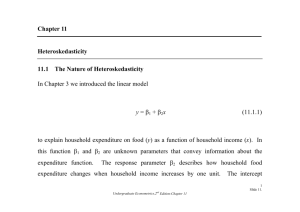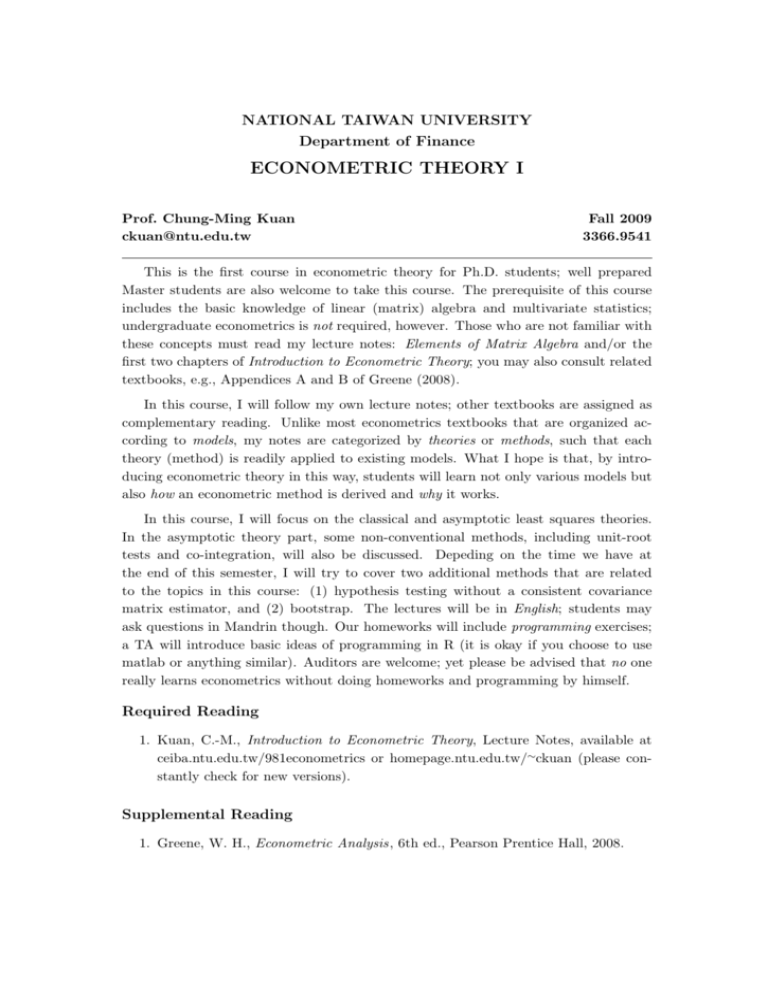
NATIONAL TAIWAN UNIVERSITY
Department of Finance
ECONOMETRIC THEORY I
Prof. Chung-Ming Kuan
ckuan@ntu.edu.tw
Fall 2009
3366.9541
This is the first course in econometric theory for Ph.D. students; well prepared
Master students are also welcome to take this course. The prerequisite of this course
includes the basic knowledge of linear (matrix) algebra and multivariate statistics;
undergraduate econometrics is not required, however. Those who are not familiar with
these concepts must read my lecture notes: Elements of Matrix Algebra and/or the
first two chapters of Introduction to Econometric Theory; you may also consult related
textbooks, e.g., Appendices A and B of Greene (2008).
In this course, I will follow my own lecture notes; other textbooks are assigned as
complementary reading. Unlike most econometrics textbooks that are organized according to models, my notes are categorized by theories or methods, such that each
theory (method) is readily applied to existing models. What I hope is that, by introducing econometric theory in this way, students will learn not only various models but
also how an econometric method is derived and why it works.
In this course, I will focus on the classical and asymptotic least squares theories.
In the asymptotic theory part, some non-conventional methods, including unit-root
tests and co-integration, will also be discussed. Depeding on the time we have at
the end of this semester, I will try to cover two additional methods that are related
to the topics in this course: (1) hypothesis testing without a consistent covariance
matrix estimator, and (2) bootstrap. The lectures will be in English; students may
ask questions in Mandrin though. Our homeworks will include programming exercises;
a TA will introduce basic ideas of programming in R (it is okay if you choose to use
matlab or anything similar). Auditors are welcome; yet please be advised that no one
really learns econometrics without doing homeworks and programming by himself.
Required Reading
1. Kuan, C.-M., Introduction to Econometric Theory, Lecture Notes, available at
ceiba.ntu.edu.tw/981econometrics or homepage.ntu.edu.tw/∼ckuan (please constantly check for new versions).
Supplemental Reading
1. Greene, W. H., Econometric Analysis, 6th ed., Pearson Prentice Hall, 2008.
2. Hayashi, F., Econometrics, Princeton University Press, 2000 (recommended).
3. Kuan, C.-M., Elements of Matrix Algebra, Lecture Notes, also available at
ceiba.ntu.edu.tw/981econometrics or homepage.ntu.edu.tw/∼ckuan.
4. White, H., Asymptotic Theory for Econometricians, revised ed., Academic Press,
1999.
Office Hours: Tuesday 3–5 and by appointment
Course Outline
Part I: Classical and Generalized Least Squares Theory (Chapters 3–4 of Lecture
Notes)
I.1 The Method of Ordinary Least Squares (OLS)
I.2 Statistical Properties of the OLS Estimator
I.3 Hypothesis Testing
I.4 Limitation of the Classical Conditions
I.5 The Method of Generalized Least Squares (GLS)
I.6 Heteroskedasticity and Serial Correlation
Part II: Asymptotic Least Squares Theory (Chapters 5–7 of Lecture Notes)
II.1 Elements of Probability Theory
II.2 Asymptotic Properties of the OLS Estimator
II.3 Consistent Estimation of Covariance Matrix
II.4 Large Sample Tests
II.5 Autoregression of an I(1) Variable and Unit-Root Tests
II.6 Tests of Stationarity against I(1)
II.7 Regressions of I(1) Variables and Cointegration
Part III: Additional Topics
III.1 Hypothesis Testing without a Consistent Covariance Matrix Estimator
III.2 Bootstrap and Applications
Grading: One midterm (40%), one final (45%), Homework (15%).
2

